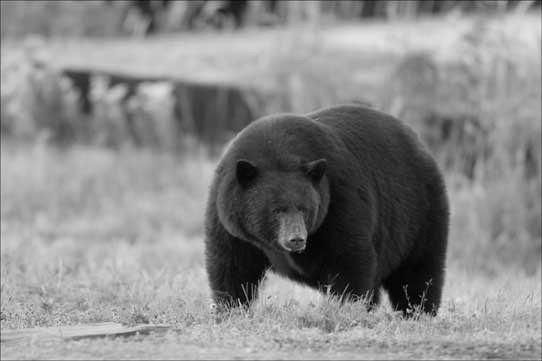Whistler Black Bear Project
People often ask me: "What kind of a year are the bears going to have?"
My reply is always the same: "Depends on the berry crop and depends on people’s attitude toward bears. Specifically, how consistent we as residents and visitors are at keeping garbage and bird feeders away from bears."
That question has formulated the goal of my research, now in its 13 th year, to examine the ever-changing variables that define a season, a year, and eventually the life of a black bear in Whistler. Over the course of 13 years, patterns and trends have been determined that with only three or even five years of research would have surely been missed.
My research began in 1994 to examine variables of seasonal food and cover, reproductive behavior/biology, kinship relations, cub growth and survival, and abundance, all of which regulate the life history of a black bear.
The basis of my research is the observation and identification-recognition of black bears utilizing clumped food sources (CFS). CFS are defined as natural and non-natural foods that are enhanced in time and space, increasing the availability of food that attracts seasonally, high bear activity. CFS monitored areas are Whistler landfill, interpretive forest skunk cabbage swamps, Fairmont-Chateau golf course, Whistler-Blackcomb summer-groomed and shrub-dominated ski trails, and shrub-dominated cut-blocks and historic wildfire burns in select areas of the RMOW.
Observations are conducted with systematic rigor during three-hour bear census periods from April through October. Bear identification is based on the ability to sight-identify and re-sight-identify select phenotypes (physical characteristics) of individual bears each season, every year. Identified bears become "known" animals, of which a subsequent sample become focal animals that are monitored to determine profiles of adaptive behavior, foraging strategies, reproductive biology, response to changes in food supply, and survival.
Bear use and abundance at CFS are crucial to understanding bear population ecology across the human-bear interface. Anecdotal evidence suggests that surrounding many B.C. communities, many residential, recreational, and industrial developments do yield an increase in bear foods.
Residential areas may provide concentrated sources of high-calorie human foods, domestic animal feed/seed, domestic/natural fruits, and green-up areas. Recreational pathways (trails and corridors), parks, golf courses, and ski areas may produce seasonal sources of grass, clover, dandelions, horsetail, catkins, insects, and berries. Industrial areas for primary resource extraction, such as logging, have created vast shrub-dominated areas with differing stages of berry abundance.
As a result of CFS, most Whistler bears have exhibited strong adaptive behaviors in order to take advantage of seasonally concentrated and supplemental food sources in large open areas, near people, and/or near associated activities. This has left us with, as a Conservation Officer once described, a super savvy bear.
To me, ski area bears are still wild – a new wild, but still wild. We can’t reverse habituation derived from cut-blocks, campsites, roads, ski trails, and golf courses, but we can dissolve links to human food sources. If you want to save a bear – truly save a bear, keep your garbage, recycling, and bird feeder inside.
If you want to kill a bear (and I know no one does), leave it out. It’s that simple. Every time a bear finds garbage, tears into a wooden shed, knocks down a bird feeder, or even licks the dried milk from the rim of a milk jug, these rewards, though minimal at the time, add up into a recognition that directs a shift one more step from wild. That reward of food, that’s so much different than natural food, is entered into the bear’s large brain for processing… and remembering.
I’d like to express thanks to Year 12 (2005) supporters – Whistler-Blackcomb bear viewing program (Arthur DeJong), Whistler-Blackcomb Employee ENVIROFUND (Allana Hamm), Resort Municipality of Whistler (Brian Barnett), Pique Newsmagazine, Fairmont-Chateau Golf Course, and BBC Natural History Unit (Simon Bell and Jeff Turner) with administrative support by the Whistler Museum and Archives Society (Karen Overgaard). Amy Gray, zoology student at Cambridge University (UK) provided valuable assistance with summer bear observations and activity-site surveys. Chris Doyle (CO Service), Sylvia Dolson (Get Bear Smart), Tony Hamilton (Bear Biologist), Whistler hotel staff, tourism operators, and members of the public provided comments and bear sighting information.




